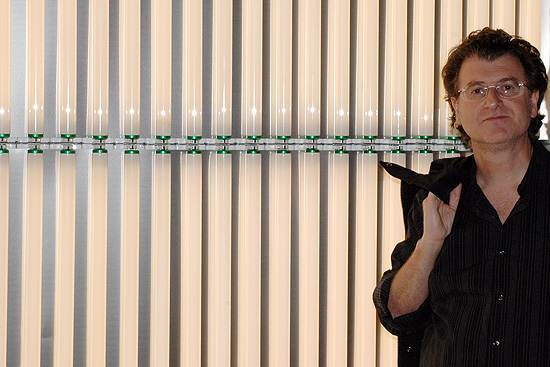Artist Examines Media Coverage of Worldly Events
 |
| Alfredo Jaar is displaying three of his exhibits inside Zilhka Gallery. |
| Posted 11/05/07 |
| Is a media giant like Newsweek able to shape public opinion by defining what is newsworthy? This is one question internationally acclaimed artist Alfredo Jaar leaves for his audience to answer in a current exhibition in Zilkha Gallery.
Jaars exhibition is on display in Zilkha Gallery through Dec. 2. He will present an art seminar at 4:15 p.m. Nov. 6 in Zilkha 106 and a music colloquium at 4:15 Nov. 7 in the Music Department. Through a straightforward photography installation that addresses the media coverage of the Rwandan genocide, Jaar expands the ongoing debate among art and cultural critics about documentary photography. His work, Untitled (Newsweek) is one of three works reflecting his ongoing examination of the dichotomy between the authority of an image and its failure to fully convey an event. The work in this exhibition examines economic and social injustice in Africa, specifically Rwanda, Angola, and Sudan. He draws attention to poverty, economic exploitation, global injustice and genocide. The work is about much more than conditions and events in these particular countriesgenocide, colonialization, and famineit is about systemic injustice, about the dynamic and tension between those who have absolute power and those who have absolutely none, suggesting parallel or related situations in Iraq, New Orleans, the Middle East, the South Bronx, or Bridgeport, Connecticut, says Nina Felshin, curator of the exhibition. Untitled (Newsweek) consists of 17 digital prints of Newsweek magazine covers chosen from issues published over a four-month period, from April 6 to Aug. 1, 1994. On April 6, the plane carrying Rwandan President Habyarimana was shot down as it was preparing to land at the airport in Kigali. This event triggered the beginning of 100 days of premeditated slaughter, which resulted in the deaths of one million members of the Tutsi minority and moderate Hutus. International response was barely audible. Newsweeks response was silence, raising questions about the mainstream medias relationship to those in power. Jaar has added text below each Newsweek cover reporting statistics and events in Rwanda that correspond to the date of the magazine. After 16 weeks of the genocide, Newsweek finally accorded it a cover. In addition to Untitled (Newsweek), a film and haunting video-installation are on display. The film, Muxima, meaning heart in Kimbundu, an indigenous language of Angola, is a cinematic elegy dedicated to the people of Angola. During the process of organizing my extensive collection of Angolan recordings, I discovered that I had in my possession six different versions of a song called ‘Muxima,'” Jaar explains. And a film was born a film that poetically portrays the evolving history of Angola through alternate interpretations of this single folk song. Muxima is rooted in his love of African music and the belief that music can resonate with and therefore help communicate the experiences of the people. The video installation, titled The Sound of Silence, features a Pulitzer Prize-winning photograph shot in the Sudan in 1993 by the late South African photojournalist Kevin Carter and the controversy it sparked. The eight-minute videotape is housed within a structure that evokes the interior of a camera obscura, forcing the viewer to become part of a captive audience while at the same time implicating us in the controversy that surrounds this image. The predominantly text-driven video challenges us to examine the broader implications of anothers suffering in terms of our personal ethics. Alfredo Jaar was born in Santiago, Chile in 1956. He currently lives and works in New York City. His work has been shown extensively around the world. He has participated in the Venice, São Paulo, Johannesburg, Sydney, Istanbul and Kwangju Biennales and in Documenta in Kassel. Major solo exhibitions have been presented at the New Museum of Contemporary Art in New York, the Whitechapel in London, the Museum of Contemporary Art in Chicago, the Pergamon Museum in Berlin and the Moderna Museet in Stockholm. He received a Guggenheim Fellowship in 1985 and was named a MacArthur Fellow in the year 2000. Alfredo Jarrs exhibition is sponsored by the Raymond E. Baldwin Lecture Fund, Office of Academic Affairs, Office of Affirmative Action, Department of Art and Art History, Raymond E. Baldwin Lecture Fund, Center for African American Studies, The Office of the Dean of the Arts and Humanities, Music Department and The President’s Office. |

